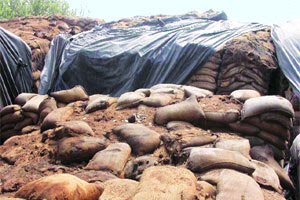POST HARVEST LOSS
 |
| source: www.indianexpress.com |
Post harvest loss could be
described as the economic loss and decrease throughout the supply chain
that leads to reduction for the intended use and return on investment.
Promotion of reduction in
post harvest loss is one means to increase efficiency in the food chain and
reduce tensions between the necessary increase in consumption and the challenge
to increase production particularly in the efforts to combat hunger, raise
income and improve food security.
With limited natural
resources (land, water, energy, fertilizer), and limited cost-effective
solutions to produce enough, reducing post harvest losses should be a number one
priority.
Post harvest loss occurs
throughout the supply chain, from initial agricultural production down to final
consumption.
Studies suggest that
roughly one-third of food produced for human consumption is lost or wasted
globally, which amounts to about 1.3 billion tons per year. This inevitably
also means that huge amounts of the resources used in food production are used
in vain, and that the greenhouse gas emissions caused by production of food
that gets lost or wasted are also emissions in vain.
Given that many smallholder
farmers in developing countries live on the margins of food insecurity, a
reduction in post harvest losses could have an immediate and significant impact
on their livelihoods.
In medium- and high-income
countries losses to a significant extent occur at the consumption stage,
meaning that it is discarded even when it is still suitable for human
consumption. Significant losses also occur early in the supply chains in the
industrialized regions.
Overall, on a per-capita
basis, much more food is wasted in the industrialized world than in developing
countries. It is estimated that the per capita food waste by consumers in
Europe and North-America is 95-115 kg/year, while this figure in Sub-Saharan Africa
and South/Southeast Asia is only 6-11 kg/year.
The causes of food losses
and waste in medium/high-income countries mainly relate to consumer behavior
as well as to a lack of coordination between different actors in the supply
chain.
Our concern today is losses
in the developing countries:
In developing countries
losses occur mostly during the early and middle stages of the food supply
chain; much less is wasted at the consumer level. Though there is some such
loss in the urban areas due to consumer behavior eg. insufficient purchase
planning and lack of coordination in farmer-buyer sales agreements and quality
and standards issues.
The causes post harvest
losses in developing countries are mainly connected to financial, managerial
and technical limitations in harvesting techniques, storage and cooling
facilities in difficult climatic conditions, infrastructure, packaging and
marketing systems.
In Ghana our
Medium Term Agriculture Sector Investment Plan (METASIP) the development issues
on losses identified were high post-harvest losses along the value chain and low
integration of commodity markets. The activities to address this include
building human capacity, warehousing and distribution and agro-processing
logistics.
Some specific
interventions are:
·
Improved information gathering and dissemination and
development of an efficient grain trade system.
·
Through extension support there will be capacity building of
producers in better harvesting, transportation and storage methods,
introduction of grading methods and linkages between producers and markets and
linking smallholders with warehousing investments.
·
Interventions for value addition will be pursued including
warehousing, agro-processing, packaging and distributing.
·
Investment in warehousing will be promoted to improve the
quality of staples along the chain and to increase trade in legumes and
cereals.
·
Warehousing is also expected to contribute to commodity
price stabilization.
·
Existing warehouses will be upgraded by installing
appropriate equipment, while new ones will be established in strategic areas in
the country.
·
MOFA and relevant agencies will put in place and enforce
grading standards to be applied in all warehousing centres.
·
Pockets of regional disparities in food availability in some
regions such as the northern regions being food insecure to be addressed
through improved food distribution network.
·
Agro-processing will be promoted through individual and
group initiatives aimed at adding value to major food staples.
·
Agro-processing will be supported with environmental
mitigation measures.
·
Gender equity will be emphasised in all activities along the
value chain to ensure that the disadvantaged, especially women and youth play a
major role in all activities.
Finally the sector policy –
Food and Agriculture Sector Development Policy (FASDEP) and the METASIP promote
a general principle of the value chain approach to increase productivity. This
promotes reduction in losses and a zero waste approach by establishing vertical
and horizontal linkages to utilize all by products through and agribusiness and
industry chain.
No comments:
Post a Comment